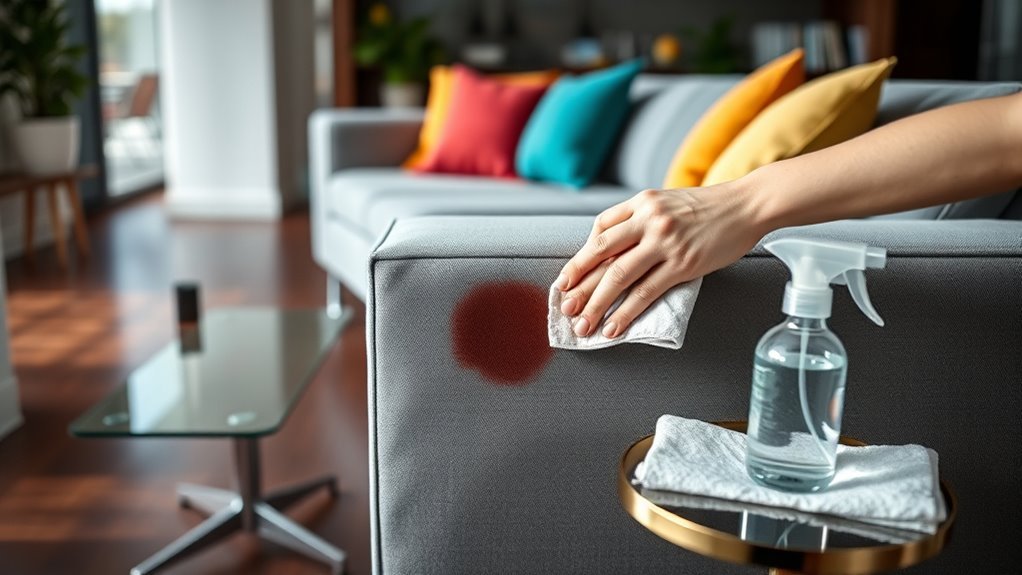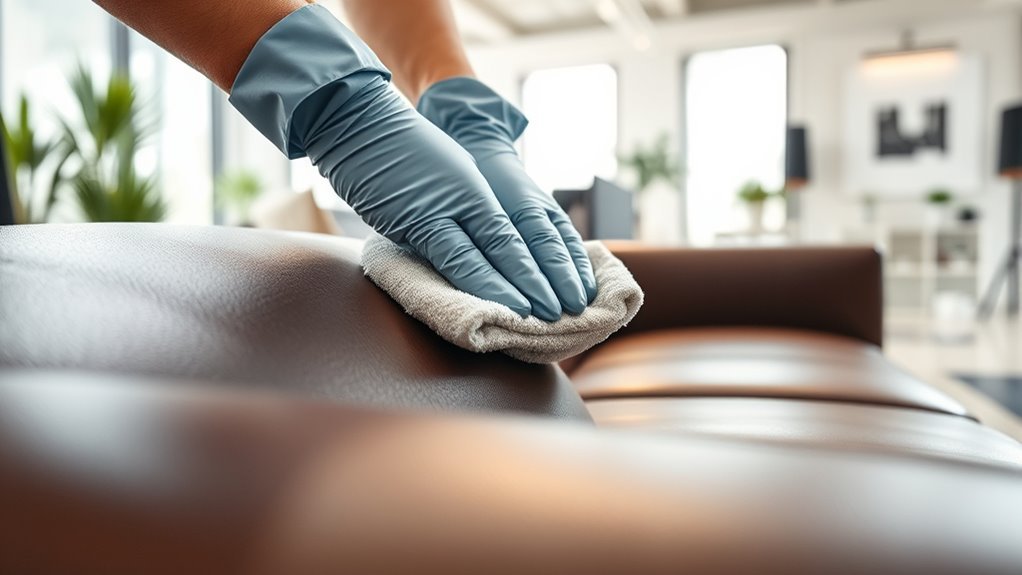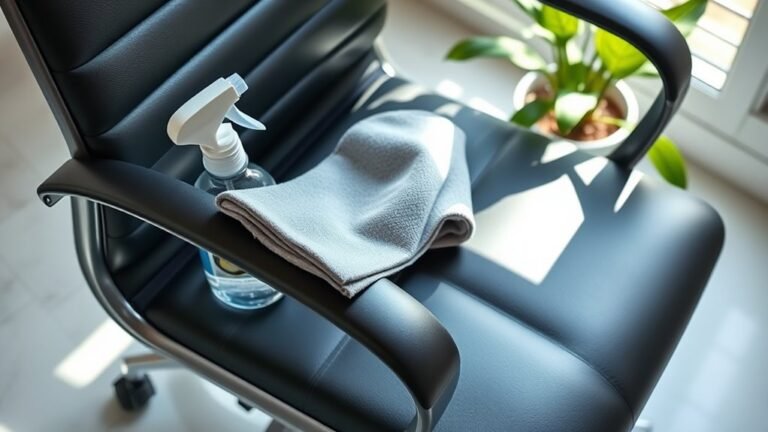How to Clean Sofa in Office Spaces
To clean your office sofa, start by identifying its material to choose the right cleaning method—leather needs gentle wipes, while fabric can handle deeper cleaning. Vacuum thoroughly to remove dust and crumbs, then spot-clean stains with appropriate solutions. For odors, sprinkle baking soda before vacuuming. Regularly rotate cushions and inspect for wear to keep it fresh and inviting. Keep going to discover easy tips for maintaining a spotless, comfortable sofa in your workspace.
Assessing the Material of Your Office Sofa

Before you begin cleaning your office sofa, it’s important to identify the material it’s made from. Different material types react uniquely to cleaning methods, so knowing the fabric characteristics helps you avoid damage. For example, leather requires gentle wipes and conditioning, while synthetic fabrics like polyester can handle more robust cleaning. Natural fibers, such as cotton or wool, might need specialized care to prevent shrinking or fading. You can usually find a tag with cleaning codes—W, S, WS, or X—that guide you on suitable cleaners. Taking this step gives you the freedom to clean confidently, preserving your sofa’s look and feel without risking costly mistakes. Understanding your sofa’s fabric is essential before you plunge into the next steps.
Gathering Essential Cleaning Supplies
Before you start cleaning, make sure you have the right tools like brushes, cloths, and a vacuum. You’ll also want to pick cleaning agents that suit your sofa’s material to avoid damage. Don’t forget protective gear like gloves to keep your hands safe during the process.
Essential Cleaning Tools
You’ll need a few essential tools to clean your sofa effectively. Having the right cleaning gadgets makes the task quicker and more enjoyable, letting you reclaim your office space with ease. Here’s what you should gather:
- Vacuum Cleaner with Attachments – Perfect for removing dust and crumbs from tight spots.
- Soft-Bristle Brush – Helps loosen dirt without harming the fabric.
- Spray Bottle for Eco Friendly Cleaners – Allows you to apply gentle, safe solutions evenly.
Choosing Appropriate Cleaning Agents
Since different sofa materials react uniquely to cleaning products, choosing the right cleaning agents is essential to avoid damage. You’ll want to select products that match your sofa’s fabric—whether it’s leather, microfiber, or cotton. Opting for eco friendly options not only protects the environment but also minimizes harsh chemical exposure in your office space. Keep chemical safety in mind by avoiding strong solvents or bleach that could cause discoloration or weaken fibers. Always test a small hidden area first to ascertain compatibility. By carefully picking your cleaning agents, you maintain your sofa’s look and feel while preserving a fresh, safe workspace. This way, you enjoy freedom from worry and keep your office inviting without compromising health or sustainability.
Protective Gear Necessities
Three key pieces of protective gear you’ll need when cleaning your sofa are gloves, masks, and eye protection. These essentials help you tackle dirt and chemicals without compromising your freedom to breathe easy or move freely.
- Cleaning gloves – Protect your hands from harsh cleaning agents and stubborn stains while keeping your skin safe and irritation-free.
- Masks – Shield your lungs from dust, allergens, and fumes. You’ll appreciate the fresh air as you work.
- Safety goggles – Prevent splashes or particles from getting into your eyes, so you can clean confidently without worry.
Wearing this gear doesn’t limit you; it empowers you to clean efficiently and stay safe. Grab these essentials before you start to protect yourself and enjoy the freedom of a fresh office sofa.
Removing Loose Dirt and Debris
Before diving into deep cleaning, start by removing any loose dirt and debris from your sofa. This step frees your couch from surface grime, making the next cleaning stages more effective. To do this, use smart vacuuming techniques—opt for a vacuum with adjustable suction and a brush attachment to gently lift dirt without damaging your fabric. Don’t forget dusting methods too; a microfiber cloth or a soft brush can reach tight corners and crevices where dust loves to settle. By tackling this first, you maintain a cleaner, fresher sofa that feels inviting and well-kept. Taking these simple steps gives you the freedom to enjoy a spotless, comfortable office space without hassle.
Spot Cleaning Stains and Spills

With loose dirt and debris out of the way, you can focus on tackling stains and spills that might have caught your eye. Spot treatment is your best friend here—it stops stains from setting and keeps your sofa looking fresh. To handle spills effectively, follow these steps:
Clear away dirt first, then tackle stains quickly with spot treatment to keep your sofa fresh and spotless.
- Blot the spill immediately with a clean cloth—don’t rub, as that spreads the stain.
- Apply a suitable spot treatment to the stained area, gently working it in with a soft brush or cloth.
- Let it sit for a few minutes, then blot again with a damp cloth to lift the residue.
This quick action guarantees stain prevention, saving you time and maintaining the freedom to enjoy a spotless office sofa without hassle.
Deep Cleaning Fabric Sofas
When it’s time for a deep clean, you’ll want to use effective stain removal techniques that don’t damage your fabric. You should also consider fabric protection tips to keep your sofa looking fresh longer. Let’s explore how to tackle stubborn stains and protect your sofa in the long run.
Stain Removal Techniques
How do you tackle stubborn stains on your fabric sofa without causing damage? Understanding stain types is your first step. Different stains need different cleaning methods. Here’s a simple guide to free your sofa from marks:
- Oil-based stains (like grease) require a gentle solvent or dish soap solution to break down the grime without soaking the fabric.
- Water-based stains (like coffee or juice) respond well to blotting with a cloth dipped in mild detergent and water.
- Protein stains (like blood) are best treated with cold water and an enzyme cleaner to dissolve the organic material.
Always test your cleaning method on a hidden area first. This way, you maintain freedom in your workspace, ensuring your sofa looks fresh without risking damage.
Fabric Protection Tips
After tackling stubborn stains, protecting your fabric sofa helps keep it looking fresh longer and makes future cleanings easier. You can use fabric sprays designed to repel liquids and prevent dirt from settling deep into fibers. These sprays create an invisible barrier, giving you more freedom to enjoy your sofa without constant worry about spills. Another smart move is investing in protective covers, especially if your office space is high-traffic. Covers shield your sofa from dust, stains, and wear, and you can easily remove and wash them as needed. Combining fabric sprays with protective covers offers a practical defense, extending your sofa’s life and maintaining its appearance. Taking these steps means less stress about messes and more time enjoying a clean, inviting workspace.
Cleaning Leather and Faux Leather Sofas

Leather and faux leather sofas each need a gentle touch to keep them looking their best. To care for them properly, follow these simple steps:
- Wipe down your sofa regularly with a soft, damp cloth to remove dust and dirt without damaging the surface.
- Use a leather conditioner to nourish genuine leather—it prevents cracking and preserves suppleness, showcasing the leather conditioner benefits.
- For faux leather care, avoid harsh chemicals; instead, opt for mild soap and water to maintain its texture and shine.
Deodorizing and Freshening Up the Sofa
Even if your sofa looks clean, it can still hold onto odors from pets, food, or everyday use. To keep it smelling fresh, try using scented sprays designed specifically for upholstery. These sprays can quickly neutralize bad smells and leave a pleasant aroma, giving your office space a boost of freshness without hassle. If you prefer something more natural, consider natural alternatives like baking soda sprinkled lightly on the fabric. Let it sit for a few hours, then vacuum it up to absorb odors effectively. Essential oils mixed with water in a spray bottle can also refresh your sofa while avoiding harsh chemicals. By choosing these options, you’re not just freshening up your sofa—you’re reclaiming the freedom to enjoy a clean, inviting workspace.
Tips for Maintaining a Clean Office Sofa Regularly
While keeping a sofa clean might seem like a big task, regular maintenance can make it much easier. You can enjoy a fresh, inviting office space by scheduling cleanings and performing routine inspections. Here’s how to stay on top of it:
- Set a monthly schedule for vacuuming and spot cleaning to prevent dirt buildup.
- Conduct weekly routine inspections to catch stains or damage early.
- Rotate cushions regularly to guarantee even wear and maintain shape.
Frequently Asked Questions
How Often Should Professional Cleaning Be Scheduled for Office Sofas?
You should schedule professional cleaning for your office sofas every 6 to 12 months to maintain ideal office hygiene. This cleaning frequency helps prevent dirt buildup, allergens, and stains, keeping the space fresh and inviting. If your office sees heavy use or spills, consider more frequent cleanings. By sticking to a regular schedule, you’re ensuring a healthier environment without feeling tied down by constant maintenance, giving you freedom to focus on what matters.
Can Office Sofas Be Cleaned Without Disrupting Daily Work Activities?
Sure, sneaky sofa scrub sessions can seamlessly slip into your schedule! By setting smart cleaning schedules during off-peak hours, you won’t stall your staff’s stride. With staff cooperation, you can coordinate quick, quiet cleans that won’t cramp anyone’s creativity or comfort. It’s all about syncing your scrubbing so everyone stays satisfied and your space stays spotless—letting you enjoy freedom from fuss and filth without forfeiting daily flow.
What Are Eco-Friendly Cleaning Options for Office Sofas?
If you want to keep your office sofas fresh without harming the environment, you’ll love using natural cleaners like vinegar, baking soda, or lemon juice. These options are gentle yet effective, aligning perfectly with sustainable practices that protect your workspace and the planet. You don’t have to sacrifice cleanliness for eco-friendliness—you can enjoy both freedom and responsibility by choosing green solutions that keep your sofas spotless and your conscience clear.
How to Handle Cleaning Allergies Caused by Sofa Cleaning Products?
Isn’t it just perfect when the cure causes more trouble? If you’re battling allergy symptoms from cleaning products, don’t just tough it out. You’ve got the freedom to choose product alternatives—like fragrance-free, hypoallergenic, or natural cleaners—that won’t make you sneeze or itch. Always test a small area first and keep the space well-ventilated. You deserve a clean space without sacrificing your health or comfort.
Are There Specific Cleaning Protocols for Sofas With Warranty Conditions?
If your sofa comes with warranty guidelines, you’ll want to carefully review any cleaning restrictions before getting started. Warranties often specify which cleaning methods or products you can use to avoid voiding coverage. Sticking to these rules lets you maintain your sofa’s condition without losing warranty protection. Don’t feel trapped—just choose approved cleaners and techniques, so you can enjoy your freedom while keeping your sofa safe and fresh.






